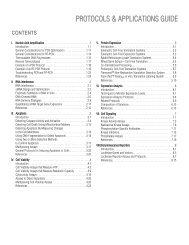2012 Promega catalogue
2012 Promega catalogue
2012 Promega catalogue
You also want an ePaper? Increase the reach of your titles
YUMPU automatically turns print PDFs into web optimized ePapers that Google loves.
Life<br />
Science<br />
Catalog<br />
<strong>2012</strong><br />
Worldwide Contact List<br />
Section<br />
Contents<br />
Table of<br />
Contents<br />
Cell Signaling<br />
62<br />
Nonphosphorylated Substrate<br />
Fluorescence (RFU)<br />
100,000<br />
90,000<br />
80,000<br />
70,000<br />
60,000<br />
50,000<br />
40,000<br />
30,000<br />
20,000<br />
10,000<br />
R110<br />
Fluorescent<br />
+ Protease<br />
Phosphorylated Substrate<br />
R110<br />
Nonfluorescent<br />
0<br />
0 10 20 30 40 50 60 70 80 90 100<br />
Percent Phosphorylated Peptide<br />
+ Protease<br />
Schematic and graph demonstrating that the presence of a<br />
phosphorylated amino acid (black circles) blocks the removal of<br />
amino acids from the PKA peptide substrate by the protease.<br />
ProFluor ® Src-Family Kinase Assay<br />
Product Size Cat.# Price ($)<br />
ProFluor ® Src-Family Kinase Assay 4 plate V1270 1185.00<br />
For Research Use Only. Not for Use in Diagnostic Procedures.<br />
8 plate V1271 2040.00<br />
Description: The ProFluor ® Src-Family Kinase Assay measures the activity<br />
of purified Src-family tyrosine kinases (Src, Lck, Lyn, Fyn, and Hck tested) in<br />
a multiwell plate format and involves “add-mix-read” steps only—ideal for<br />
high-throughput applications. The assay begins with a standard kinase reaction<br />
performed with a provided Src-family kinase bisamide rhodamine 110 peptide<br />
substrate. Following the kinase reaction, a termination buffer containing a<br />
protease reagent is added, which simultaneously stops the kinase reaction and<br />
removes amino acids specifically from the nonphosphorylated substrate, liberating<br />
highly fluorescent rhodamine 110. Phosphorylated substrate, however,<br />
is resistant to digestion by the protease reagent and remains nonfluorescent.<br />
Thus, fluorescence intensity measured in this assay is inversely correlated with<br />
kinase activity. A control peptide (AAF-AMC) is included to control for compounds<br />
that may inhibit the protease. The assay produces excellent Z´ values<br />
(>0.7) in either 96- or 384-well plate formats and easily distinguishes known<br />
Src-family kinase inhibitors from other compounds.<br />
Features:<br />
• Achieve Highly Predictive Results: Robust Z´ values greater than 0.7 in<br />
either 96- or 384-well plate formats.<br />
• Observe Minimal Test Compound Interference: Fluorescent signal<br />
from Rhodamine 110 is much stronger than fluorescents signal given off<br />
by test compounds.<br />
• Control Peptide Included: Use AAF-AMC control peptide to monitor<br />
protease activity and reduce false-positive hits.<br />
• Homogeneous: Add-mix-read format reduces the number of platehandling<br />
steps.<br />
• Non-Radioactive: No radioactive waste disposal and safety issues.<br />
Storage Conditions: For long-term storage, store the system at –20°C.<br />
Protect the Src-Family Kinase R110 Substrate and Control AMC Substrate from<br />
light. Avoid multiple freeze-thaw cycles or exposure to frequent temperature<br />
changes. These fluctuations can greatly alter product stability.<br />
Protocol Part#<br />
ProFluor ® Src-Family Kinase Assay Technical Bulletin TB331<br />
3876MD<br />
SAM 2® Biotin Capture Membrane<br />
Product Size Cat.# Price ($)<br />
SAM2® Biotin Capture Membrane 96 samples V2861 400.00<br />
For Laboratory Use.<br />
7.6 × 10.9 cm V7861 416.00<br />
Description: The SAM 2® Biotin Capture Membrane binds biotinylated molecules<br />
based on their affinity for streptavidin. The proprietary process by which<br />
the SAM 2® Membrane is produced results in a high density of streptavidin on<br />
the filter, providing rapid, quantitative substrate binding in the nmol/cm 2 range,<br />
depending upon the substrate used. In addition, the membrane is designed<br />
to minimize nonspecific binding. The membrane is available either as a large,<br />
prenumbered, partially cut sheet (approximately 10.5 × 15.0cm; Cat.# V2861)<br />
or as a smaller, uncut sheet (approximately 7.6 × 10.9cm; Cat.# V7861). The<br />
partially cut membrane allows easy separation into 96 individual squares and is<br />
designed for small-scale experiments where high binding capacity is required.<br />
The uncut sheet can be analyzed as a whole membrane or may be cut to<br />
the size desired. The uncut membrane allows for sample application using a<br />
multichannel pipettor. Both membranes may be analyzed using phosphorimaging<br />
analysis, autoradiography or scintillation counting to quantitate results. The<br />
membranes have also been used successfully with chemiluminescence detection<br />
techniques. The use of fluorescence for detection of captured molecules is<br />
not recommended at this time.<br />
Features:<br />
• Use a Variety of Substrates: Analysis of biotinylated substrates can be<br />
applied to a wide variety of substrate types without the need to optimize<br />
each substrate for binding to a matrix. The user can perform experiments<br />
with a wide array of sample numbers and sizes without changing the<br />
analysis technique, since the membrane is available in 96-square (partially<br />
cut) and solid sheet (uncut) formats.<br />
• Minimize Nonspecific Binding: The combination of protein denaturant<br />
and high-salt washes minimizes nonspecific binding to the membrane<br />
without interfering with the high-affinity interaction between streptavidin<br />
and biotin.<br />
• Obtain High Signal-to-Noise Ratios: The stringent washing conditions<br />
employed assist in attaining very low background counts.<br />
• Perform Kinetic Studies: Membrane can linearly bind biotinylated<br />
substrates up to the nmol/cm 2 range. Allows for kinetic studies.<br />
• Strong Binding Reaction: Membrane retains the biotin conjugate over 8<br />
logs of pH (pH 2–10), changes in temperature, organic solvents, ionic and<br />
nonionic detergents (SDS, CHAPS, Triton ® X-100, Tween ® 20 and Tween ®<br />
80) and denaturing agents (5M guanidine-HCl and 2M urea).<br />
• Rapid: Binds within 1 minute.<br />
• Convenient: Compatible with enzyme assays using radioactive detection.<br />
Membranes manufactured by this method have been shown to allow<br />
chemiluminescent detection.<br />
Storage Conditions: Store membranes at –20°C in resealable bag.<br />
Protocol Part#<br />
SAM2® Biotin Capture Membrane Technical Bulletin TB547<br />
For complete and up-to-date product information visit: www.promega.com/catalog
















